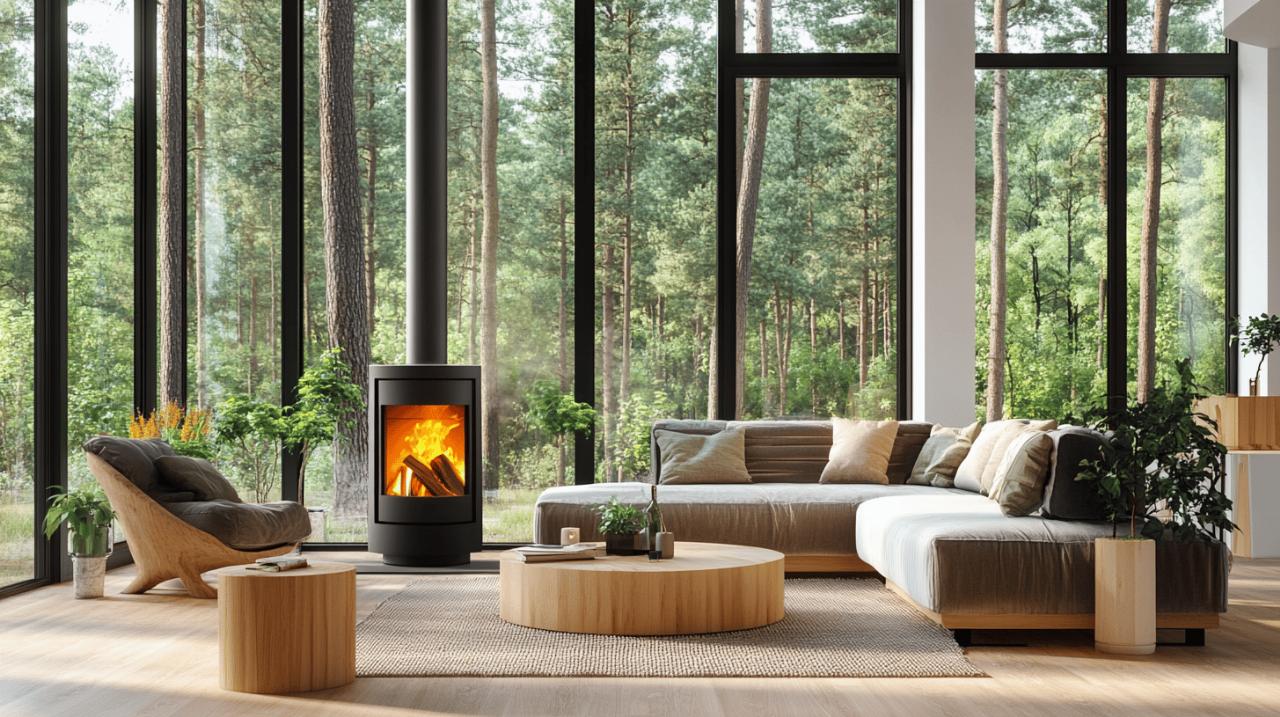Selecting the perfect wood-burning stove can feel a bit like navigating a maze, particularly when you're faced with technical specifications and jargon. One of the most critical decisions you'll make involves choosing the appropriate power output for your specific space. However, what many homeowners overlook is how dramatically the quality and moisture content of your firewood influences these calculations. Understanding why dry logs make such a significant difference to your kilowatt requirements can save you money, improve comfort, and ensure your wood-burning stove operates at peak efficiency throughout the heating season.
Understanding Wood Burner Power Output and kW Ratings
What Does kW Actually Mean for Your Wood-Burning Stove?
When you're browsing wood-burning stoves, you'll notice each model displays a kilowatt rating, which indicates the amount of heat energy the appliance can generate under optimal conditions. A kilowatt is simply a unit of power that measures the rate at which energy is transferred or converted. For wood-burning stoves, this figure tells you how much warmth the appliance can deliver to your living space. Think of it as the stove's potential heating capacity, much like how a car's horsepower indicates its potential performance on the road.
These ratings typically range from small stoves offering around three to five kilowatts, suitable for compact rooms or even glamping pods, up to larger models exceeding eight kilowatts designed for expansive open-plan areas or poorly insulated properties. The manufacturers determine these figures through standardised testing procedures, which involve burning specific fuels under controlled conditions. However, the real-world performance of your wood-burning stove will depend on numerous variables, including the quality of fuel you use, how well you operate the appliance, and the characteristics of your home.
How nominal power output differs from real-world performance
The kilowatt rating displayed on a wood-burning stove represents what manufacturers call the nominal output, which is essentially the heat produced when the appliance burns fuel at its most efficient rate under laboratory conditions. This figure serves as a useful starting point for comparison shopping, but it doesn't tell the complete story of how your stove will perform in your actual living room. Real-world conditions introduce countless variables that can significantly alter the amount of usable heat you'll receive from your investment.
Your home's insulation quality, the number and size of windows, ceiling height, local climate, and even how draughty your property is will all influence how much heat you actually need and how effectively your stove delivers it. A well-insulated modern home will retain heat far more effectively than a Victorian terrace with single-glazed windows and no cavity wall insulation. Similarly, a room with high ceilings requires considerably more heating capacity than a similar floor area with standard ceiling heights. Understanding these distinctions helps you make a more informed decision when selecting your wood-burning stove, ensuring you don't end up with an appliance that's either struggling to warm your space or roasting you out of your own home.
Why moisture content in logs dramatically affects your heating requirements
The science behind burning wet versus dry logs
The moisture content of your firewood fundamentally changes how your wood-burning stove performs and how much heat reaches your living space. When you burn logs with high moisture content, a substantial portion of the combustion energy is wasted simply evaporating the water trapped within the wood fibres before the wood can actually burn and produce heat. This process is remarkably inefficient, as evaporating water requires considerable energy that could otherwise be warming your home. Wet or inadequately seasoned logs might contain thirty percent moisture or more, meaning nearly a third of the potential heat energy is lost to steam production.
In contrast, properly kiln-dried logs contain less than twenty percent moisture content, with premium products often achieving levels below fifteen percent. This dramatic reduction in water content means far more of the combustion energy translates directly into radiant and convection heat that warms your living space. The difference isn't marginal; burning dry logs can increase your stove's effective heat output by as much as thirty to forty percent compared to burning damp wood. Additionally, wet logs produce far more smoke and particulate emissions, contributing to air pollution and creating dangerous creosote buildup in your chimney or flue liner, which poses a serious fire hazard over time.
How properly seasoned wood maximises your stove's efficiency
When you invest in kiln-dried logs or properly seasoned firewood, you're not simply buying fuel; you're purchasing efficiency and performance that directly impacts your heating costs and comfort levels. Dry logs ignite more quickly and burn at higher temperatures, producing a cleaner combustion process that generates less smoke and fewer harmful emissions. This cleaner burn is particularly important if your stove features modern cleanburn technology or catalytic converters, as these systems are designed to work optimally with low-moisture fuel and can struggle or become damaged when regularly exposed to the excessive smoke from damp wood.
The enhanced efficiency of burning dry logs means you'll use less fuel overall to achieve the same heating effect, which translates into genuine cost savings despite the higher upfront price of quality kiln-dried logs compared to inadequately seasoned alternatives. Your airwash system will also function more effectively, keeping the glass door clear so you can enjoy watching the flames dance whilst the stove heats your home. Furthermore, the reduced creosote buildup means less frequent chimney cleaning, lower maintenance costs, and significantly reduced risk of dangerous chimney fires. When you factor in all these considerations, the initial investment in properly dried firewood pays dividends throughout the heating season in terms of performance, safety, and overall running costs.
Calculating the Correct Power Output for Your Home with Dry Fuel
Assessing room volume, insulation, and heat loss factors
 Determining the appropriate kilowatt rating for your wood-burning stove begins with accurately assessing your heating space and understanding how your property retains warmth. Start by calculating your room volume by multiplying the length, width, and height in metres. A typical living room measuring four metres long, three metres wide, and two and a half metres high would have a volume of thirty cubic metres. This figure forms the foundation of your calculation, but you'll need to adjust it based on your property's insulation characteristics and heat retention capabilities.
Determining the appropriate kilowatt rating for your wood-burning stove begins with accurately assessing your heating space and understanding how your property retains warmth. Start by calculating your room volume by multiplying the length, width, and height in metres. A typical living room measuring four metres long, three metres wide, and two and a half metres high would have a volume of thirty cubic metres. This figure forms the foundation of your calculation, but you'll need to adjust it based on your property's insulation characteristics and heat retention capabilities.
Well-insulated modern homes with double glazing, cavity wall insulation, and proper loft insulation require less heating power per cubic metre than older properties with single glazing and solid walls. As a general guideline, you might need approximately one kilowatt of output for every fourteen cubic metres in a well-insulated space, whilst poorly insulated properties might require one kilowatt for every ten cubic metres or even less. Large windows, particularly those facing north, represent significant sources of heat loss, as do poorly sealed doors and draughty floorboards. If your property sits in a particularly exposed location or experiences harsh winter conditions, you'll want to factor in additional heating capacity to compensate for these challenging environmental factors.
Adjusting your kw requirements when using kiln-dried logs
Once you've established a baseline kilowatt requirement using traditional calculation methods, you can refine this figure by considering the superior performance characteristics of kiln-dried logs. Because properly dried firewood burns more efficiently and delivers more usable heat per kilogram than damp wood, you may actually be able to select a slightly lower-rated stove than conventional calculations might suggest. This approach can save you money on the initial purchase whilst still providing adequate heating, as the enhanced combustion efficiency of dry logs compensates for the reduced nominal output.
For example, if your initial calculation suggested you needed a seven kilowatt stove based on room volume and insulation factors, you might find that a six kilowatt model performs perfectly adequately when consistently fuelled with kiln-dried logs containing less than twenty percent moisture. This adjustment isn't simply theoretical; the cleaner, hotter burn produced by dry logs generates more radiant heat and maintains more consistent temperatures throughout the heating cycle. However, this strategy requires discipline in sourcing and storing your firewood properly. You'll need to maintain consistent fuel quality by purchasing certified kiln-dried logs or ensuring any seasoned wood you acquire has been properly dried and stored in a ventilated location. Using a moisture meter to verify your fuel quality before burning provides peace of mind and ensures you're genuinely achieving the efficiency gains that justify selecting a lower-output stove.
Common mistakes when selecting wood burner power output
Why oversizing your stove can cost you money and comfort
Many homeowners instinctively lean towards purchasing a more powerful wood-burning stove than their calculations suggest, operating under the assumption that having extra heating capacity provides a safety margin and greater flexibility. Whilst this logic seems reasonable on the surface, oversizing your stove actually creates numerous problems that diminish comfort and increase operating costs. An excessively powerful appliance will rapidly overheat your living space, forcing you to operate the stove at very low burn rates with minimal air flow to avoid turning your lounge into a sauna. This low-temperature operation is precisely the wrong way to run a wood-burning stove, as it promotes incomplete combustion, excessive smoke production, and accelerated creosote accumulation in your flue system.
Operating an oversized stove at persistently low outputs also reduces the effectiveness of modern emission control features like cleanburn technology and catalytic converters, which require adequate operating temperatures to function properly. You'll find yourself constantly adjusting air controls, opening windows despite having the heating on, and generally struggling to achieve comfortable stable temperatures. The airwash system may struggle to keep the glass clean at low burn rates, robbing you of the pleasure of watching the flames. Additionally, you'll waste money on the higher purchase price of the larger appliance whilst using it inefficiently, negating any supposed benefits from having extra capacity. Selecting the correctly sized stove for your actual requirements, particularly when using high-quality kiln-dried logs, provides far better results in terms of comfort, efficiency, and overall satisfaction with your heating system.
The Hidden Costs of Using Damp Wood in an Incorrectly Sized Appliance
Combining an incorrectly sized wood-burning stove with poor-quality damp firewood creates a perfect storm of inefficiency, excessive maintenance, and potential safety hazards. When you burn wet logs in an oversized stove that you're already operating at low outputs to avoid overheating, you're creating conditions that maximise creosote production whilst minimising heat delivery to your living space. The cool flue gases from the low-temperature burn condense on chimney surfaces, depositing thick layers of creosote that require frequent professional cleaning and pose serious fire risks if allowed to accumulate.
An undersized stove faced with damp firewood presents different but equally problematic issues. You'll struggle to achieve adequate temperatures in your living space, leading to the temptation to overfire the appliance by leaving air controls wide open and cramming in excessive amounts of fuel. This practice can damage your stove, void warranties, and create dangerous situations including chimney fires or damaged flue liners. The excessive smoke from burning wet wood in a struggling undersized stove also contributes significantly to local air pollution, potentially causing issues with neighbours and local authorities, particularly if you live within a Smoke Control Area where only DEFRA-exempt stoves operated with appropriate fuel are permitted. Investing in properly kiln-dried logs with verified low moisture content and selecting the correctly sized appliance based on accurate calculations transforms your wood-burning experience, providing reliable comfortable heat whilst minimising maintenance requirements, operating costs, and environmental impact. Taking the time to get both these factors right from the outset saves considerable frustration and expense throughout the lifetime of your heating system.




